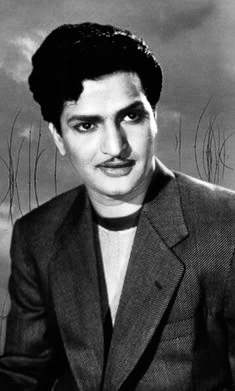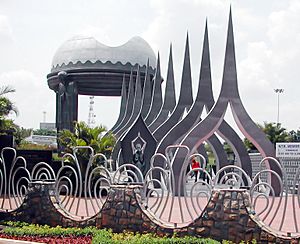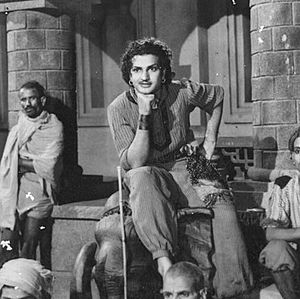N. T. Rama Rao facts for kids
Quick facts for kids
N. T. Rama Rao
|
|
|---|---|

N. T. Rama Rao in 1955
|
|
| 10th Chief Minister of Andhra Pradesh | |
| In office 12 December 1994 – 1 September 1995 |
|
| Governor | Krishan Kant |
| Cabinet | NTR IV |
| Preceded by | Kotla Vijaya Bhaskara Reddy |
| Succeeded by | N. Chandrababu Naidu |
| In office 16 September 1984 – 2 December 1989 |
|
| Governor |
|
| Cabinet | NTR II & III |
| Preceded by | Nadendla Bhaskara Rao |
| Succeeded by | Marri Chenna Reddy |
| In office 9 January 1983 – 16 August 1984 |
|
| Governor |
|
| Cabinet | NTR I |
| Preceded by | Kotla Vijaya Bhaskara Reddy |
| Succeeded by | Nadendla Bhaskara Rao |
| 10th Leader of the Opposition in the Andhra Pradesh Legislative Assembly | |
| In office 5 January 1990 – 10 December 1994 |
|
| Governor |
|
| Chief Minister |
|
| Preceded by | Mogaligundla Baga Reddy |
| Succeeded by | P. Janardhan Reddy |
| Member of Legislative Assembly, Andhra Pradesh | |
| In office 1985–1996 |
|
| Preceded by | Pamishetty Ranganayakulu |
| Succeeded by | Nandamuri Harikrishna |
| Constituency | Hindupuram |
| In office 1983–1985 |
|
| Preceded by | Katari Satyanarayana Rao |
| Succeeded by | Raavi Sobhanadri Chowdary |
| Constituency | Gudivada |
| 1st President of Telugu Desam Party | |
| In office 29 March 1982 – 1 September 1995 |
|
| General Secretary | N. Chandrababu Naidu (1983–1995) |
| Preceded by | Position established |
| Succeeded by | N. Chandrababu Naidu |
| Personal details | |
| Born |
Nandamuri Taraka Rama Rao
28 May 1923 Nimmakuru, Madras Presidency, British India (now in Andhra Pradesh, India) |
| Died | 18 January 1996 (aged 72) Hyderabad, Andhra Pradesh, India (now in Telangana, India) |
| Cause of death | Heart attack |
| Resting place | NTR Gardens |
| Political party | Telugu Desam Party |
| Spouses |
|
| Relations | Nandamuri family |
| Children | 12 |
| Occupation |
|
| Awards | Padma Shri (1968) |
| Signature | |
Nandamuri Taraka Rama Rao (28 May 1923 – 18 January 1996), also known by his initials NTR, was a famous Indian actor, filmmaker, and politician. He served as the Chief Minister of Andhra Pradesh for seven years. Many people think of him as one of the greatest actors in the history of Indian cinema.
NTR starred in more than 300 movies, mostly in the Telugu language. He was so famous that people called him Viswa Vikhyatha Nata Sarvabhouma, which means "Universally-renowned star of acting." He was known for playing gods from Hindu stories, especially Krishna and Rama. His acting made him a hero to many people. In 2013, a national poll named him the "Greatest Indian Actor of All Time."
Besides acting, NTR was also a successful politician. In 1982, he started the Telugu Desam Party (TDP). He wanted to support the culture and pride of the Telugu-speaking people of Andhra Pradesh. He also helped form the National Front, a group of political parties that governed India from 1989 to 1990.
Contents
Early Life
Nandamuri Taraka Rama Rao was born on May 28, 1923, in Nimmakuru, a small village in Andhra Pradesh, India. He was born into a farming family. Because his aunt and uncle did not have children, they adopted him.
His father loved the arts and made sure NTR got a good education. After finishing high school, NTR went to college and earned a bachelor's degree. He even got a good government job, but he left it after only three weeks to follow his dream of becoming an actor.
Personal Life
In 1943, when he was 20 years old, NTR married Basava Tarakam. They had twelve children together: eight sons and four daughters. Some of his children, like Nandamuri Harikrishna and Nandamuri Balakrishna, also became famous actors. His grandson, N. T. Rama Rao Jr., is a major star in Telugu cinema today.
Sadly, his wife Basava Tarakam passed away from cancer in 1985. To honor her, NTR built a large cancer hospital in Hyderabad. In 1993, he married a writer named Lakshmi Parvathi.
Film Career
NTR's first movie role was a small part as a policeman in Mana Desam (1949). He became very popular for playing Hindu gods in his movies. He played the god Krishna in 17 different films, including the famous movie Mayabazar (1957). He also played the god Rama in movies like Lava Kusa (1963).
He didn't just play heroes. He also played powerful characters like the demon king Ravana. Some of his most famous films, like Pathala Bhairavi (1951) and Mayabazar, are considered some of the greatest Indian films ever made.
Later in his career, he played heroes who fought for poor and working-class people. These movies were very popular with audiences. Some of these hit films include Adavi Ramudu (1977), Vetagadu (1979), and Bobbili Puli (1982).
NTR was very dedicated to his work. When he was 40, he learned a special type of classical dance called Kuchipudi just for a role in the film Nartanasala. He also directed and produced many films. He won three National Film Awards, which are among the highest honors for movies in India.
Political Career
In 1982, NTR decided to enter politics. He started his own political party called the Telugu Desam Party (TDP). He said he wanted to get rid of corruption and bring pride to the Telugu people.
First Term as Chief Minister (1983)
NTR had a new way of campaigning. He traveled all over Andhra Pradesh in a special van called the Chaitanya Ratham ("Chariot of Awakening"). His son Harikrishna drove the van, and NTR would speak to huge crowds from the top of it. His slogan was Telugu Vari Atma Gauravam, which means "Self-respect for the Telugu people."
His campaign was a huge success. In the 1983 election, the TDP won a big majority of the seats. On January 9, 1983, NTR became the 10th Chief Minister of Andhra Pradesh. He was the first person to become Chief Minister who was not from the Congress party.
A Short Break and Return to Power (1984)
In August 1984, while NTR was in the United States for heart surgery, the state governor removed him from his job. Another politician, Nadendla Bhaskara Rao, was made the new Chief Minister.
NTR immediately returned to India. He showed that most of the state's politicians still supported him. He traveled on his Chaitanya Ratham again, this time to fight for democracy. With support from the people and other political parties, he was made Chief Minister again just one month later.
Second Term as Chief Minister (1985)
After returning to power, NTR called for a new election to let the people choose their leaders again. The TDP won another big victory, and NTR began his second term as Chief Minister. During this time, the TDP also became the main opposition party in India's national parliament, the Lok Sabha. This was a major achievement for a party from a single state.
National Politics and Third Term
In 1989, NTR helped form the National Front, a group of parties that were not part of the Congress party. This group governed India for about a year.
NTR returned to power in Andhra Pradesh for a third time after a big win in the 1994 elections. However, in 1995, there were disagreements within his party. This led to his son-in-law, N. Chandrababu Naidu, taking over as Chief Minister.
Death
N. T. Rama Rao died of a heart attack on January 18, 1996, at his home in Hyderabad. He was 72 years old.
Legacy

N. T. Rama Rao left a lasting impact on both cinema and politics. Several awards are named after him, including the NTR National Award for lifetime achievement in the Indian film industry.
Many important places and institutions were founded by him or named in his honor, including:
- Dr. N.T.R. University of Health Sciences
- Potti Sreeramulu Telugu University
- The large Buddha Statue of Hyderabad in the middle of Hussain Sagar lake.
- NTR Gardens, a memorial park in Hyderabad.
Awards and Honors
Civilian Honours
| Year | Award | Honouring body | Outcome |
|---|---|---|---|
| 1968 | Padma Shri | Government of India | Won |
Other Honours
| Year | Award | Honouring body | Outcome |
|---|---|---|---|
| 1978 | Honorary Doctorate | Andhra University | Won |
Filmfare Awards South
| Year | Category | Film | Outcome |
|---|---|---|---|
| 1972 | Best Actor – Telugu | Badi Panthulu | Won |
National Film Awards
| Year | Category | Film | Outcome |
|---|---|---|---|
| 1954 | Best Feature Film in Telugu (as producer) | Thodu Dongalu | Won |
| 1960 | Best Feature Film in Telugu (as producer) | Sita Rama Kalyanam | Won |
| 1968 | Best Feature Film in Telugu (as director) | Varakatnam | Won |
See also
 In Spanish: N. T. Rama Rao para niños
In Spanish: N. T. Rama Rao para niños
- List of chief ministers of Andhra Pradesh
- Government of Andhra Pradesh
- Elections in Andhra Pradesh
- Politics of Andhra Pradesh




